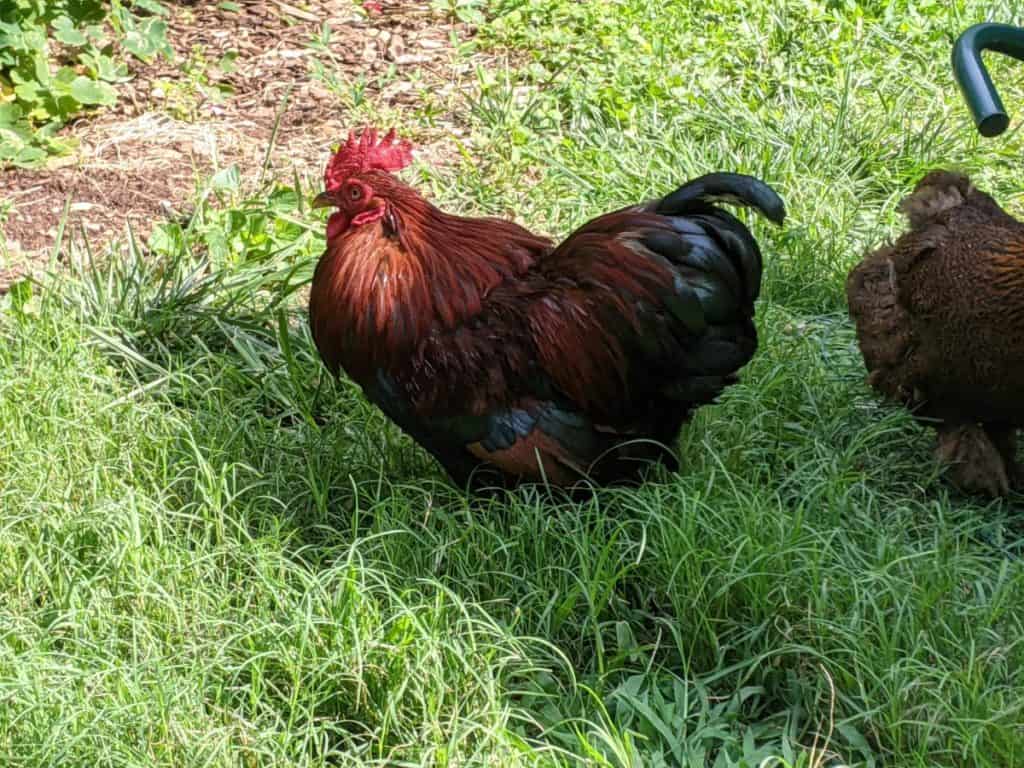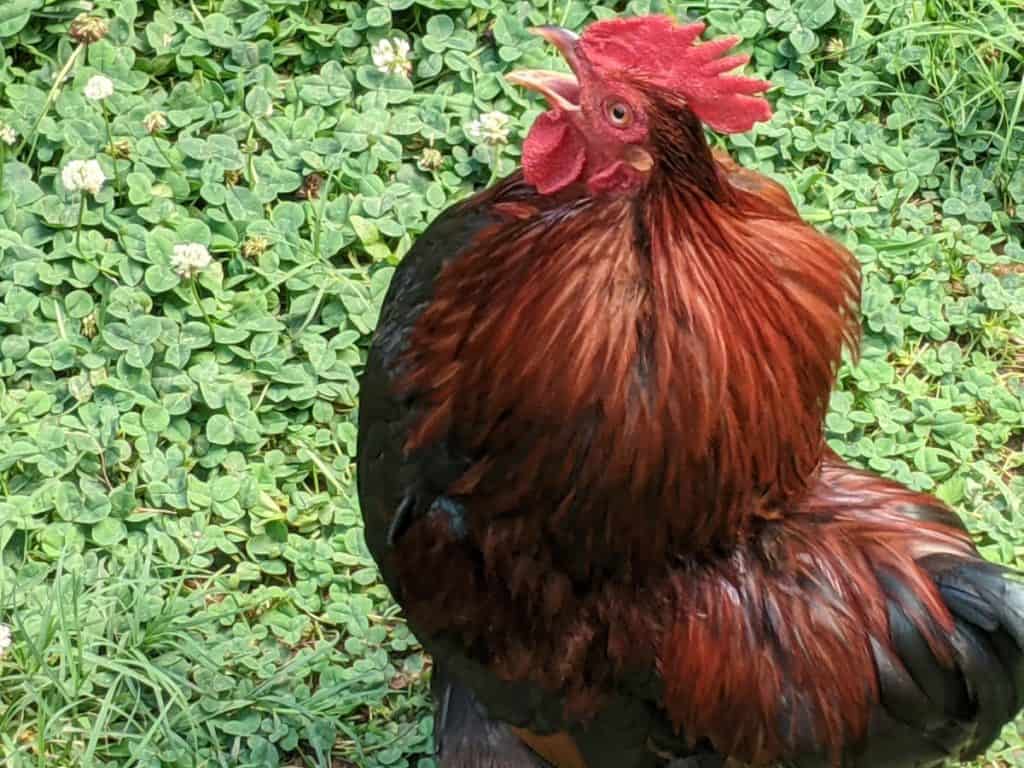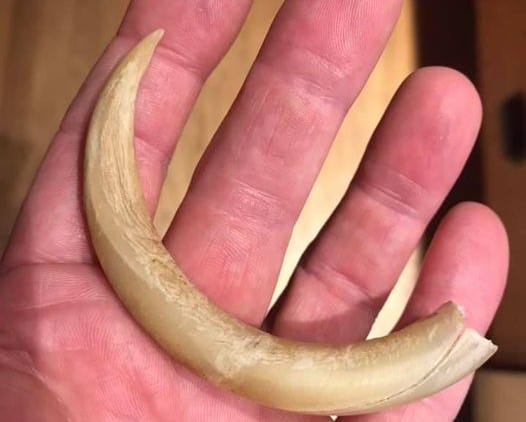If you have delved into the chicken world at all, you have probably come across an aggressive rooster at some stage. My current bantam cochin rooster has an aggressive side.
Although roosters are small compared to people, they can still be frightening when they chase you. There are many hilarious videos on the web showing people being chased by roosters.
Although it is entertaining to watch, roosters can seriously injure and frighten people, especially children. Chicken keepers face the dilemma of what to do with aggressive roosters. Should they simply be culled and put in the pot, or is there some way to rehabilitate their behavior?
Aggressive roosters do not need to be culled due to their behavior. Picking up the rooster and holding him until he is calm or shooting the rooster with a strong jet of water will discourage aggression. Do not try and interact with the rooster with behavior that mimics his aggression.
This article looks at various methods to deal with aggressive roosters. The techniques are described, and tips are provided on the best way to achieve a harmonious chicken coop.
The article will also consider things you should not do when dealing with aggressive roosters. Information will be given on why roosters become aggressive and is there anything that can be done to prevent it.

Why Do Roosters Suddenly Become Aggressive?
Roosters may be the sweetest little chicks until they begin to reach sexual maturity at around five to six months. Small breed chickens tend to achieve sexual maturity earlier. Large breed chickens only become sexually mature later – sometimes as late as nine or ten months.
The sudden surge of testosterone as the rooster reaches the age of sexual maturity results in aggressive behavior. Some roosters become calmer after a few months as their hormones become more stable, but some roosters remain aggressive for the rest of their lives.
Certain Chicken Breeds Have More Aggressive Roosters.
Genetics plays a huge role in influencing behavior. Small breeds of chicken are often more aggressive. There is a reason for the phrase “as cocky as a bantam rooster.” Although they are a big chicken breed, Rhode Island Red roosters are renowned for being aggressive roosters.
Old English Game roosters and Malay roosters were bred for cockfighting. These roosters are exceptionally aggressive and will attack animals much larger than themselves.
What Is The Purpose Of Aggression In Roosters?
Roosters are the protectors of their flock of hens and chicks. They cry the alarm if they spot predators and will usually rush in to engage a predator to prevent harm to the flock. Roosters are admirably brave in defending their chickens.
Aggression in roosters is helpful in nature, but there are times when the rooster is overly aggressive and attacks not just perceived predators but also attacks members of his own flock. It also poses a problem when roosters begin attacking people. They can inflict nasty lacerations with their sharp spurs, and the bony edges of their wings can give a surprisingly strong blow.
The video below shows our rooster chasing my daughter and scaring her. Ever since this day she will not go outside with the flock unless my husband or me go with her.
When Should You Correct Behavior In Aggressive Roosters?
If your rooster has just reached sexual maturity and becomes aggressive, you can ignore it for a few months and see if he outgrows the behavior, or you can use one of the methods described to nip the behavior in the bud. The decision you make should be based on the level of aggression and your own personality.
If the rooster is exceptionally aggressive, it is better to deal with the behavior straight away. If it is only minor aggression, you can wait to see if there is any improvement. A chicken keeper that lacks confidence around the birds should deal with the behavior as soon as possible. Roosters will take advantage of any lack of confidence to escalate aggression.
If you have children who interact with the chickens, it is also best to immediately address rooster aggression. Children are small enough for roosters to fly at their faces, and they could potentially have eye damage and facial scarring from a rooster slashing them with his spurs.

What Is A Chicken Pecking Order?
Chickens are social birds with a solid hierarchy that governs their interactions. Roosters are usually the most dominant chicken in the flock. Very few roosters will tolerate another rooster around his hens.
If a rooster feels he is more dominant than people, he will often attack. Most methods to deal with aggressive roosters are founded on addressing this dominance issue.
Pick Up And Pet Method
This method is based on two precepts. The first is showing the rooster that you are more dominant than him. The second is allowing the rooster to experience positive interactions with people.
Every time you enter the chicken coop, pick up the rooster as gently as possible. Hold his wings trapped against his body and pet him softly. Hold the rooster as you walk around doing your house duties. If the rooster is huge, then you can sit and just hold him for at least ten minutes.
It is essential that you repeat this every time you interact with the rooster. If the rooster continues to struggle, hold him until he calms down. The rooster must be calm and relaxed when you put him down. If he is still trying to fight, pick him up and hold him for a further five to ten minutes. The rooster should get to the point where he enjoys the petting.
This method is one of the best methods. It does not encourage the rooster to fight because picking him up is not part of a rooster’s fighting strategy, so he is not encouraged to fight. The petting uses positive reinforcement learning theory to replace the unwanted aggressive behavior with behavior the rooster enjoys.
It is best if you kept up the technique for several weeks before you stop. Some roosters need refresher courses every couple of months.
Water Pistol/ Spray Bottle
This technique is based on the learning principle of using an unpleasant negative consequence to discourage unwanted behavior. Using either a water pistol or a spray bottle spray water at the rooster whenever he becomes aggressive.
Some people like to use a spray bottle but very often, the water jet is not strong enough from a spray bottle. A water pistol that delivers a stream of water with strong pressure is a better option. The water is not what the rooster is expecting. He expects you to fight him by running at him, kicking, and being aggressive.
The water pistol distances you from the rooster. This has two benefits. It does not encourage the rooster to fight more, and it keeps you safe from injury. Keep using this technique until the rooster no longer displays aggressive behavior towards you.
Submissive Chicken Approach
Some chicken keepers feel that when a rooster is aggressive, it is best to behave as a submissive chicken would. Turn sideways, do not make eye contact with the rooster, and walk away. There are some significant problems with this approach.
Many roosters are so aggressive that they do not posture before attacking. There is no warning, and it is challenging to act submissively with a rooster raking his spurs down your leg or face and beating you with his wings.
The submissive behavior can reinforce the rooster’s aggression. It is also difficult to complete chores in the chicken house if you must continually behave submissively and keep clear of the rooster.
Feeding Treats To Counteract Aggression In Roosters.
There are chicken owners that feel that crouching down and offering treats to the aggressive rooster will overcome his aggression. This method has no basis in fundamental learning theory.
When he approaches you aggressively, giving the rooster treats is rewarding that behavior and will encourage him to act aggressively whenever he encounters you.

Spur Management In Roosters.
Spurs are sharp curved claws that occur on a rooster’s leg. The spur is situated above the foot on the inside of the leg. Rooster spurs can become very dangerous, harming not only people but also the hens in the flock. Some spurs curl back on themselves and can injure the rooster.
Spurs can be removed completely, but a veterinarian must do this as there is a bone that supports the spurs, which must be removed. This procedure is done under anesthetic and must be carefully done to not damage the leg bone.
Spurs can be cauterized in young chicks to prevent the growth of the spur altogether. Roosters without spurs are often less aggressive.
Spurs can be filed down using a grinding head-on, a Dremel crafters tool, or a similar tool. A file can also be used. Hold the rooster securely in a towel with one leg extended at a time. File down the spur to take off the sharp point. Be careful not to file too deeply as you may damage the blood supply or bone.
Spurs can be clipped using pet nail clippers. The nail clippers should be sharp and large enough to cut the spur in one quick cut. Once again, use caution so that you do not damage the bone or blood supply.
Spurs have a bone surrounded by keratin that forms that sharp claw or nail of the spur. Take a hot boiled potato and push the spur into the potato. Hold the spur in the potato for a few minutes. This softens the keratin.
Taking a pair of pliers, grasp the sharp claw part and twist it while pulling. The entire keratin section of the spur will come off. This method removes the spur and does not cause any injury to the underlying bone. Repeat the procedure with the spur on the other leg. There are no nerves in the keratin, and the rooster does not feel any pain.
What Shouldn’t You Do When Dealing With An Aggressive Rooster?
- Do not flap your arms and scream.
- Do not kick and try and fight like another rooster. This encourages more aggressive behavior.
- Do not tease the rooster in any way.
Conclusion
An aggressive rooster should be dealt with calmly and with minimum fuss. The rooster can be picked up and held or shot with a water pistol to discourage aggressive behavior.
Do not reinforce the rooster’s aggression by giving him treats when he is aggressive. The rooster needs to understand that he is below you on the pecking order.

